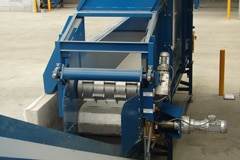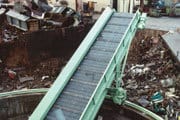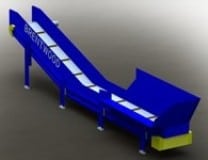Apron Feeders
 |  |  |
| Bulky Waste Feeder with Roller | Straight Feeder Conveyor | Apron Feeder with Bend |
|---|
 |  |  |
| Bulky Waste Feeder with Roller | Straight Feeder Conveyor | Apron Feeder with Bend |
|---|
A Brentwood Apron Feeder is a conveyor manufactured from steel plates driven by steel chains wearing on steel surfaces. They are a robust design manufactured for durability in the arduous environment of the toughest industrial applications.
Manufactured in several designs including:
The unique design of these apron feeders enables them to convey products with excessive weight, sharpness, temperature or abrasiveness. By comparison, flexible belt conveyors become an unjustifiable maintenance expense or are simply incapable of doing the job.
Brentwood Apron Feeders are constructed from interconnecting steel plates through a piano hinge arrangement. They are specifically designed to convey loose or stringy material without the mechanical jams which occur in other designs. They are also designed to convey heavy products. By sharing the load between flights and minimising excessive loads on the drive chain, maintenance costs are reduced.
The Brentwood Apron Feeder is a quality product manufactured and designed in Australia. It has been developed from years of experience in the waste and recycling industry by Brentwood engineers. These conveyors have been successfully marketed into:
– Metal Scrap Operations
– Municipal Waste Environments
– Steel Processing Plants
– Smelting Works
– Waste Paper Processing Plants
CLICK THE IMAGE ABOVE TO WATCH FEEDER VIDEOS
Brentwood Recycling Systems developed the Brentwood Apron Feeder many years ago from a necessity to feed municipal waste in the form of builders waste, concrete, green vegetation, tyres and putrescible waste, into our Multi-Purpose Shredding Plants. These plants are located on municipal tips where the working environment is arduous and maintenance programmes can be minimal.
Brentwood’s product research indicated a need for a chain driven conveying system which had some unique features such as the ability to handle exceptionally heavy and sharp objects at the same time as handling almost granular products.
Although this concept had been attempted before using overlapping plates, the Brentwood design using a hinge pin meant the conveyor could be manufactured at a considerably lower capital cost with reduced maintenance costs.
Over the years, this successful design has been updated in several areas to further improve maintenance through the introduction of steel wear plates and steel wear blocks. An “extra heavy duty” design has been developed to handle very heavy sharp objects dropping onto the conveying flights of the conveyor.
Through the development of these conveyors, Brentwood has maintained close relationships with all of our customers and enjoy the respect our customers have for our conveyors and their ability to do the intended job.
1. Piano Hinged Steel Flights
The steel flight provides a hardy and durable surface on which to convey difficult materials and each flight is interconnected by a piano hinge with the hinge going through the centre line of the roller.
2. Hardened Steel Support Pads
On the underside of the flights, hardened steel blocks wear against replaceable hardened steel wear tracks fixed to the frame. This provides the machine with reduced maintenance and longer life of wearing parts.
3. Hardened Replaceable Wear Track
This wear track is fully supported by longitudinal members on the frame of the conveyor. The wear track can be easily replaced by simply removing 6 – 10 flights.
4. “No Gaps” between Flights
The hinged connection between the flights means the gaps between one flight and another are very small. This allows the conveying of smaller sized product, be it in granular size down to 3 – 5 mm or in the form of stringy material, (e.g. wire or strapping), without the material getting jammed between the flights. This problem commonly occurs in apron feeders with press flights which overlap, or in apron feeders using ‘K’ attachments having the flights mounted above the centre-line of the chain.
Mounting the pivot hinge directly in the centre of the rollers ensures the centre line of the hinge and the centre line of the rollers are in the same line as the centre line of the chain. Therefore the minimal gaps (a critical advantage of the Brentwood Apron Feeder) are maintained through all changes in direction of the conveyor flights. This change of direction can be the conveyor running over the head or tail sprockets or can also be through a change in the direction of the conveyor, ie a slope up or down.
5. Case Hardened Roller Pins
Every hollow roller pin runs on the flight hinge pin. These hinge pins are hardened to give long life at the area where the roller runs.
6. Flange Rollers
Rollers on the Brentwood Apron Feeder incorporate a flange which assists in tracking of the conveyor along its length.
7. Rollers Running on Replaceable Wear Plates
The chain, including its rollers, is located over the top of a replaceable wear plate. This wear plate is dowelled and bolted into the main frame of the conveyor. In addition to this wear plate on the load bearing side of the conveyor frame, the return side of the conveyor runs on another replaceable wear strip on the inside of the frame. This means that should in time the environment wear out these wearing surfaces, they are easily replaced to restore the conveyor to its new condition.
8. Hardened Wear Pads
The vertical load of the material being conveyed is supporting by the hardened wear pads on the replaceable wear tracks in the centre of the conveyor. The number of these wear tracks varies, depending on the width, and the loads to be transported.
This design is different to many designs of apron feeders where a chain with ‘K’ attachments has an eccentric load imposed on it and any bending in the flight means the chain becomes twisted which results in uneven wear on the rollers.
The Brentwood design ensures a well supported and even load on the rollers at all times with no twisting of the chain through bending of the flights.
9. Lubrication
This is provided where applicable through a continuous drip system incorporated in the Brentwood Apron Feeder. An “oiler bar” feeds oil to each of the chains through an oil wick. It is fed from an oil tank mounted on the side of each conveyor frame.
10. Heavy Duty Industrial Structure
Brentwood Apron Feeders Brentwood Apron Feeders are built for industrial applications and are designed to handle the most arduous environments. Multiple support beams running the length of the conveyor support the load and these are transferred to the side members through a number of cross beams. Bracing is included on all frames and the supporting legs for these structures would be considered in industrial terms to be a heavy design.
11. Flight Deflector Plates
In many Brentwood Apron Feeders, plates are incorporated onto the end of each flight which act as a deflector for material which is being conveyed. Material is deflected away from the chains and the rollers by these overlapping plates to ensure a longer life to the chains.
12. Guarding
Guarding is incorporated in all conveyors on the top surface over the chain and around the sprockets. Where necessary, guarding can be fitted on the underside of the conveyors to protect operators from any moving parts. All guarding is removable.
13. Top Chain Guards
The top chain guards which run the length of the conveyor frame on the top of the chains, in some designs can form side skirts for the conveyor up to 1m high or even higher if used as a live bottom to a bin.